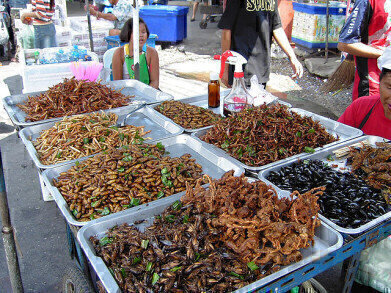LC-MS
Entomophagy — Creepy Crawlies Can Feed the World
Apr 01 2016
With the World’s population increasing at an ever faster rate, the ability to feed people is a growing concern. The Food and Agriculture Organization of the United Nations (FAO) has a programme that monitors food security and hunger around the world — and identifies practices that can alleviate hunger.
One of the ways that people can gain food security — when people have the access and ability to feed themselves — is by increasing the type of things we eat and creepy crawlies are a delicacy that we could be eating soon.
Entomophagy — not just for celebrities
Entomophagy is the practice of eating insects, (including spiders and centipedes). Insects can be a valuable food source in many areas where traditional agriculture is difficult to practice. Although rare in most countries, there are areas of the world — areas of Africa and Central and South America — where insects provide a significant nutritional food source.
The FAO estimates that there are almost 1500 different edible insect species that are known about — and with an estimated 80% of the Earth’s species still undiscovered — thousands of new species could find their way onto the menu soon.
But it’s not steak is it?
While people in the developed world might find the prospect distasteful — eating insects is healthy for people and much healthier for the environment than the flatulent and burping cow. And while the jury is might be out on which tastes better — sorry vegetarians — how nutritious are bugs?
One FAO report carries data comparing yellow mealworms (larvae from beetles easy to produce in Western countries) and beef. Although beef had a slightly higher protein and energy content (per 100g), the mealworms had a lower fat content. The mealworms generally had a higher vitamin content and similar minerals content compared to beef. But, it should be noted that insect nutritional values vary — not only between species but also between lifecycle stages.
As for taste, well the biggest hurdle could be preconceptions. Since we think they look disgusting — we’ll think they taste disgusting and that could be hard to overcome. But individually, different insects have been compared to sunflower seeds, or have a nutty taste when they are roasted. And besides — some people eat sprouts.
All food has to be stored properly
With entomophagy likely to increase, it is a good time to be reminded that food storage is important no matter what the foodstuff. A recent study published in PLOS ONE has reported that even insects have to be handled and stored with care or they can become contaminated. A team used several chromatographic techniques and found mycotoxin carcinogens in insects stored using traditional methods — the mycotoxins were absent when the insects were stored in clean bags.
Techniques such as QuEChERS as described in the article, The Applications of QuEChERS Beyond Fruits and Vegetables might become increasingly important as we attempt to feed the world with novel foods.
Would you eat a stink-bug?
Image from Wikimedia Commons
Digital Edition
Chromatography Today - Buyers' Guide 2022
October 2023
In This Edition Modern & Practical Applications - Accelerating ADC Development with Mass Spectrometry - Implementing High-Resolution Ion Mobility into Peptide Mapping Workflows Chromatogr...
View all digital editions
Events
ACS National Meeting - Fall 2024
Aug 18 2024 Denver, CO, USA
Sep 04 2024 Chiba, Tokyo, Japan
Sep 04 2024 University of Warwick, Coventry, UK
Sep 10 2024 Rockville, MD, USA
Plastics Recycling World Expo Europe
Sep 11 2024 Brussels, Belgium














